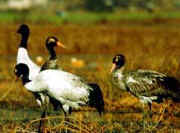Black-necked Crane
(Grus nigricollis)
Habitat: grassland in plateaus, farm fields and marsh.
Feeding habits: catch small aquatic animals in shallow water with its bill or dig foods from mud and soil.
Food: fish, insects, mollusk, roots and stems of vegetation.
Size: large-sized wading bird with a body length of 1.2 m. Weight: 5000 g.
 Habits:
migrant bird. Black-necked cranes act in pairs in mating seasons and act together with their family groups or act in groups at other time. During the mating period, the male and female cranes often cry to each other. Their cries sound like "ge-lu". They dance elegantly to attract spouses. They build their nests in safe places in marshland. They produce 2 eggs each time and the male and the female will hatch the eggs in turn. If their food is enough, the two young birds can all grow up; otherwise, only one of them can grow up. Black-necked crane is the latest specie found by scientists among all the 15 types of cranes. The Russian explorer, Przevalski found them around Qinghai Lake in 1876. It is the only kind of crane that lives in plateau areas. Black-necked crane produce their young in marshlands in-between el. 3500-4500 in the South of Qinghai-Tibet Plateau and spend their winter in the highlands or mountains in-between el. 3500-2500 of Yunnan-Guizhou Plateau. Only a few of them spend winter in India; therefore, it is usually regarded as endemic bird specie of China. Habits:
migrant bird. Black-necked cranes act in pairs in mating seasons and act together with their family groups or act in groups at other time. During the mating period, the male and female cranes often cry to each other. Their cries sound like "ge-lu". They dance elegantly to attract spouses. They build their nests in safe places in marshland. They produce 2 eggs each time and the male and the female will hatch the eggs in turn. If their food is enough, the two young birds can all grow up; otherwise, only one of them can grow up. Black-necked crane is the latest specie found by scientists among all the 15 types of cranes. The Russian explorer, Przevalski found them around Qinghai Lake in 1876. It is the only kind of crane that lives in plateau areas. Black-necked crane produce their young in marshlands in-between el. 3500-4500 in the South of Qinghai-Tibet Plateau and spend their winter in the highlands or mountains in-between el. 3500-2500 of Yunnan-Guizhou Plateau. Only a few of them spend winter in India; therefore, it is usually regarded as endemic bird specie of China.
Category: Ave, Gruiformes, Gruidae
Distribution: Northeast and Northwest Yunnan, Qinghai-Tibet Plateau and nearby places.
Level of protection: Class I key state protection animal of China
 
|